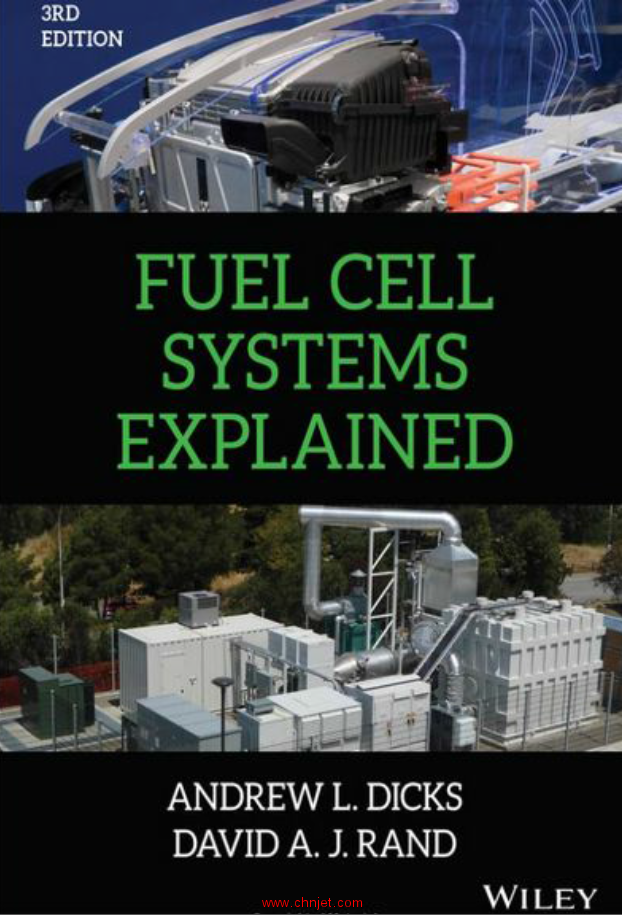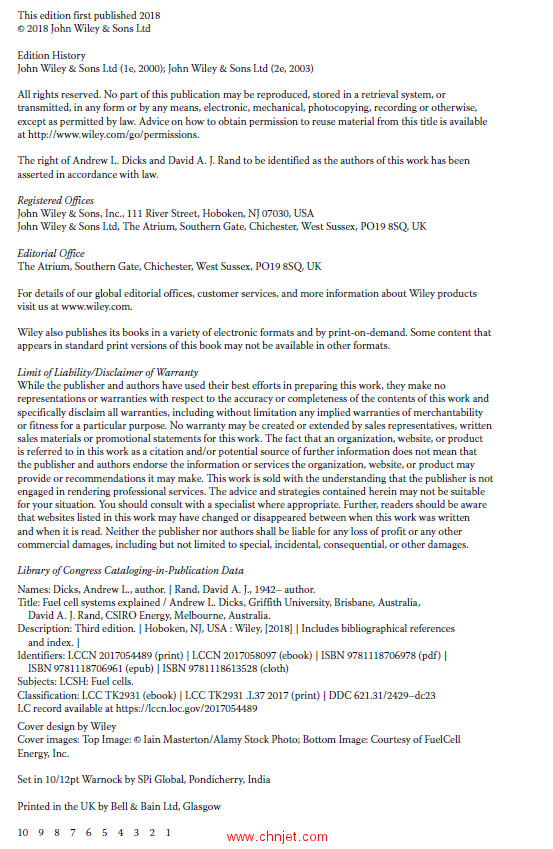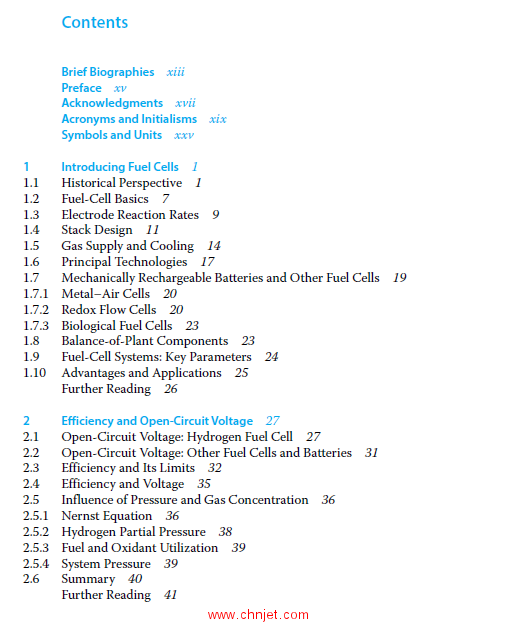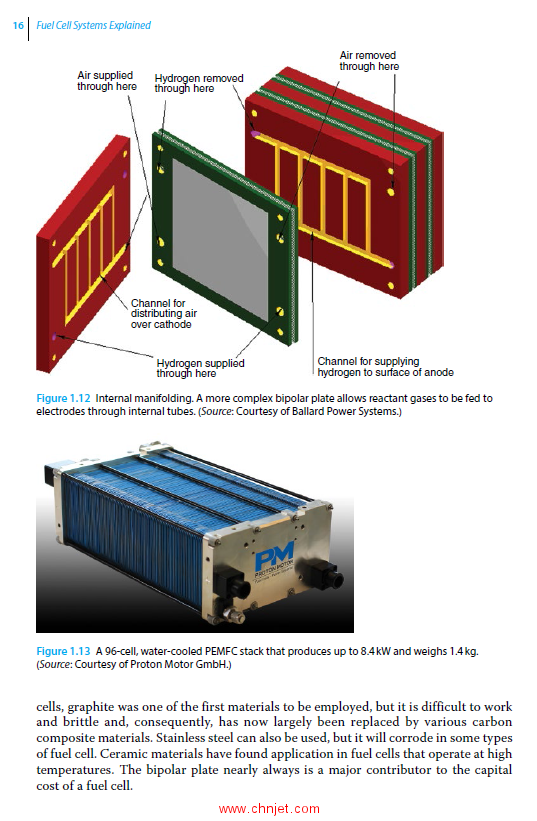马上注册,结交更多好友,享用更多功能,让你轻松玩转社区。
您需要 登录 才可以下载或查看,没有账号?立即注册

×
《Fuel Cell Systems Explained》第三版
燃料电池系统解释
作者:
Andrew L. Dicks
David A. J. Rand
出版社:Wiley
出版时间:2018年
《Fuel Cell Systems Explained》第三版

《Fuel Cell Systems Explained》第三版

《Fuel Cell Systems Explained》第三版

《Fuel Cell Systems Explained》第三版

目录
Brief Biographies xiii
Preface xv
Acknowledgments xvii
Acronyms and Initialisms xix
Symbols and Units xxv
1 Introducing Fuel Cells 1
1.1 Historical Perspective 1
1.2 Fuel‐Cell Basics 7
1.3 Electrode Reaction Rates 9
1.4 Stack Design 11
1.5 Gas Supply and Cooling 14
1.6 Principal Technologies 17
1.7 Mechanically Rechargeable Batteries and Other Fuel Cells 19
1.7.1 Metal–Air Cells 20
1.7.2 Redox Flow Cells 20
1.7.3 Biological Fuel Cells 23
1.8 Balance‐of‐Plant Components 23
1.9 Fuel‐Cell Systems: Key Parameters 24
1.10 Advantages and Applications 25
Further Reading 26
2 Efficiency and Open‐Circuit Voltage 27
2.1 Open‐Circuit Voltage: Hydrogen Fuel Cell 27
2.2 Open‐Circuit Voltage: Other Fuel Cells and Batteries 31
2.3 Efficiency and Its Limits 32
2.4 Efficiency
and Voltage 35
2.5 Influence
of Pressure and Gas Concentration 36
2.5.1 Nernst Equation 36
2.5.2 Hydrogen Partial Pressure 38
2.5.3 Fuel and Oxidant Utilization 39
2.5.4 System Pressure 39
2.6 Summary 40
Further Reading 41
3 Operational Fuel‐Cell Voltages 43
3.1 Fundamental Voltage: Current Behaviour 43
3.2 Terminology 44
3.3 Fuel‐Cell Irreversibilities 46
3.4 Activation Losses 46
3.4.1 The Tafel Equation 46
3.4.2 The Constants in the Tafel Equation 48
3.4.3 Reducing the Activation Overpotential 51
3.5 Internal Currents and Fuel Crossover 52
3.6 Ohmic Losses 54
3.7 Mass‐Transport Losses 55
3.8 Combining the Irreversibilities 57
3.9 The Electrical Double-Layer 58
3.10 Techniques for Distinguishing Irreversibilities 60
3.10.1 Cyclic Voltammetry 60
3.10.2 AC Impedance Spectroscopy 61
3.10.3 Current Interruption 65
Further Reading 68
4 Proton‐Exchange Membrane Fuel Cells 69
4.1 Overview 69
4.2 Polymer Electrolyte: Principles of Operation 72
4.2.1 Perfluorinated Sulfonic Acid Membrane 72
4.2.2 Modified Perfluorinated Sulfonic Acid Membranes 76
4.2.3 Alternative Sulfonated and Non‐Sulfonated Membranes 77
4.2.4 Acid–Base Complexes and Ionic Liquids 79
4.2.5 High‐Temperature Proton Conductors 80
4.3 Electrodes and Electrode Structure 81
4.3.1 Catalyst Layers: Platinum‐Based Catalysts 82
4.3.2 Catalyst Layers: Alternative Catalysts for Oxygen Reduction 85
4.3.2.1 Macrocyclics 86
4.3.2.2 Chalcogenides 87
4.3.2.3 Conductive Polymers 87
4.3.2.4 Nitrides 87
4.3.2.5 Functionalized Carbons 87
4.3.2.6 Heteropolyacids 88
4.3.3 Catalyst Layer: Negative Electrode 88
4.3.4 Catalyst Durability 88
4.3.5 Gas‐Diffusion Layer 89
4.4 Water Management 92
4.4.1 Hydration and Water Movement 92
4.4.2 Air Flow and Water Evaporation 94
4.4.3 Air Humidity 96
4.4.4 Self‐Humidified Cells 98
4.4.5 External Humidification: Principles 100
4.4.6 External Humidification: Methods 102
4.5 Cooling and Air Supply 10
4.5.1 Cooling with Cathode Air Supply 104
4.5.2 Separate Reactant and Cooling Air 104
4.5.3 Water Cooling 105
4.6 Stack Construction Methods 107
4.6.1 Introduction 107
4.6.2 Carbon Bipolar Plates 107
4.6.3 Metal Bipolar Plates 109
4.6.4 Flow‐Field Patterns 110
4.6.5 Other Topologies 112
4.6.6 Mixed Reactant Cells 114
4.7 Operating Pressure 115
4.7.1 Technical Issues 115
4.7.2 Benefits of High Operating Pressures 117
4.7.2.1 Current 117
4.7.3 Other Factors 120
4.8 Fuel Types 120
4.8.1 Reformed Hydrocarbons 120
4.8.2 Alcohols and Other Liquid Fuels 121
4.9 Practical and Commercial Systems 122
4.9.1 Small‐Scale Systems 122
4.9.2 Medium‐Scale for Stationary Applications 123
4.9.3 Transport System Applications 125
4.10 System Design, Stack Lifetime and Related Issues 129
4.10.1 Membrane Degradation 129
4.10.2 Catalyst Degradation 129
4.10.3 System Control 129
4.11 Unitized Regenerative Fuel Cells 130
Further Reading 132
5 Alkaline Fuel Cells 135
5.1 Principles of Operation 135
5.2 System Designs 137
5.2.1 Circulating Electrolyte Solution 137
5.2.2 Static Electrolyte Solution 140
5.2.3 Dissolved Fuel 142
5.2.4 Anion‐Exchange Membrane Fuel Cells 144
5.3 Electrodes 147
5.3.1 Sintered Nickel Powder 147
5.3.2 Raney Metals 147
5.3.3 Rolled Carbon 148
5.3.4 Catalysts 150
5.4 Stack Designs 151
5.4.1 Monopolar and Bipolar 151
5.4.2 Other Stack Designs 152
5.5 Operating Pressure and Temperature 152
5.6 Opportunities and Challenges 155
Further Reading 156
6 Direct Liquid Fuel Cells 157
6.1 Direct Methanol Fuel Cells 157
6.1.1 Principles of Operation 160
6.1.2 Electrode Reactions with a Proton‐Exchange Membrane Electrolyte 160
6.1.3 Electrode Reactions with an Alkaline Electrolyte 162
6.1.4 Anode Catalysts 162
6.1.5 Cathode Catalysts 163
6.1.6 System Designs 164
6.1.7 Fuel Crossover 165
6.1.8 Mitigating Fuel Crossover: Standard Techniques 166
6.1.9 Mitigating Fuel Crossover: Prospective Techniques 167
6.1.10 Methanol Production 168
6.1.11 Methanol Safety and Storage 168
6.2 Direct Ethanol Fuel Cells 169
6.2.1 Principles of Operation 170
6.2.2 Ethanol Oxidation, Catalyst and Reaction Mechanism 170
6.2.3 Low‐Temperature Operation: Performance and Challenges 172
6.2.4 High‐Temperature Direct Ethanol Fuel Cells 173
6.3 Direct Propanol Fuel Cells 173
6.4 Direct Ethylene Glycol Fuel Cells 174
6.4.1 Principles of Operation 174
6.4.2 Ethylene Glycol: Anodic Oxidation 175
6.4.3 Cell Performance 176
6.5 Formic Acid Fuel Cells 176
6.5.1 Formic Acid: Anodic Oxidation 177
6.5.2 Cell Performance 177
6.6 Borohydride Fuel Cells 178
6.6.1 Anode Catalysts 180
6.6.2 Challenges 180
6.7 Application of Direct Liquid Fuel Cells 182
Further Reading 184
7 Phosphoric Acid Fuel Cells 187
7.1 High‐Temperature Fuel‐Cell Systems 187
7.2 System Design 188
7.2.1 Fuel Processing 188
7.2.2 Fuel Utilization 189
7.2.3 Heat‐Exchangers 192
7.2.3.1 Designs 193
7.2.3.2 Exergy Analysis 193
7.2.3.3 Pinch Analysis 194
7.3 Principles of Operation 196
7.3.1 Electrolyte 196
7.3.2 Electrodes and Catalysts 198
7.3.3 Stack Construction 199
7.3.4 Stack Cooling and Manifolding 200
7.4 Performance 201
7.4.1 Operating Pressure 202
7.4.2 Operating Temperature 202
7.4.3 Effects of Fuel and Oxidant Composition 203
7.4.4 Effects of Carbon Monoxide and Sulfur 204
7.5 Technological Developments 204
Further Reading 206
8 Molten Carbonate Fuel Cells 207
8.1 Principles of Operation 207
8.2 Cell Components 210
8.2.1 Electrolyte 211
8.2.2 Anode 213
8.2.3 Cathode 214
8.2.4 Non‐Porous Components 215
8.3 Stack Configuration and Sealing 215
8.3.1 Manifolding 216
8.3.2 Internal and External Reforming 218
8.4 Performance 220
8.4.1 Influence of Pressure 220
8.4.2 Influence of Temperature 222
8.5 Practical Systems 223
8.5.1 Fuel Cell Energy (USA) 223
8.5.2 Fuel Cell Energy Solutions (Europe) 225
8.5.3 Facilities in Japan 228
8.5.4 Facilities in South Korea 228
8.6 Future Research and Development 229
8.7 Hydrogen Production and Carbon Dioxide Separation 230
8.8 Direct Carbon Fuel Cell 231
Further Reading 234
9 Solid Oxide Fuel Cells 235
9.1 Principles of Operation 235
9.1.1 High‐Temperature (HT) Cells 235
9.1.2 Low‐Temperature (IT) Cells 237
9.2 Components 238
9.2.1 Zirconia Electrolyte for HT‐Cells 238
9.2.2 Electrolytes for IT‐Cells 240
9.2.2.1 Ceria 240
9.2.2.2 Perovskites 241
9.2.2.3 Other Materials 243
9.2.3 Anodes 243
9.2.3.1 Nickel‐YSZ 243
9.2.3.2 Cathode 245
9.2.3.3 Mixed Ionic–Electronic Conductor Anode 246
9.2.4 Cathode 247
9.2.5 Interconnect Material 247
9.2.6 Sealing Materials 248
9.3 Practical Design and Stacking Arrangements 249
9.3.1 Tubular Design 249
9.3.2 Planar Design 251
9.4 Performance 253
9.5 Developmental and Commercial Systems 254
9.5.1 Tubular SOFCs 255
9.5.2 Planar SOFCs 256
9.6 Combined‐ Cycle and Other Systems 258
Further Reading 260
10 Fuels for Fuel Cells 263
10.1 Introduction 263
10.2 Fossil Fuels 266
10.2.1 Petroleum 266
10.2.2 Petroleum from Tar Sands, Oil Shales and Gas Hydrates 268
10.2.3 Coal and Coal Gases 268
10.2.4 Natural Gas and Coal‐Bed Methane (Coal‐Seam Gas) 270
10.3 Biofuels 272
10.4 Basics of Fuel Processing 275
10.4.1 Fuel‐Cell Requirements 275
10.4.2 Desulfurization 275
10.4.3 Steam Reforming 277
10.4.4 Carbon Formation and Pre‐Reforming 280
10.4.5 Internal Reforming 281
10.4.5.1 Indirect Internal Reforming (IIR) 283
10.4.5.2 Direct Internal Reforming (DIR) 283
10.4.6 Direct Hydrocarbon Oxidation 284
10.4.7 Partial Oxidation and Autothermal Reforming 285
10.4.8 Solar–Thermal Reforming 286
10.4.9 Sorbent‐Enhanced Reforming 287
10.4.10 Hydrogen Generation by Pyrolysis or Thermal Cracking of Hydrocarbons 289
10.4.11 Further Fuel Processing: Removal of Carbon Monoxide 290
10.5 Membrane Developments for Gas Separation 293
10.5.1 Non‐Porous Metal Membranes 293
10.5.2 Non‐Porous Ceramic Membranes 294
10.5.3 Porous Membranes 294
10.5.4 Oxygen Separation 295
10.6 Practical Fuel Processing: Stationary Applications 295
10.6.1 Industrial Steam Reforming 295
10.6.2 Fuel‐Cell Plants Operating with Steam Reforming of Natural Gas 296
10.6.3 Reformer and Partial Oxidation Designs 298
10.6.3.1 Conventional Packed‐Bed Catalytic Reactors 298
10.6.3.2 Compact Reformers 299
10.6.3.3 Plate Reformers and Microchannel Reformers 300
10.6.3.4 Membrane Reactors 301
10.6.3.5 Non‐Catalytic Partial Oxidation Reactors 302
10.6.3.6 Catalytic Partial Oxidation Reactors 303
10.7 Practical Fuel Processing: Mobile Applications 304
10.8 Electrolysers 305
10.8.1 Operation of Electrolysers 305
10.8.2 Applications 307
10.8.3 Electrolyser Efficiency 312
10.8.4 Photoelectrochemical Cells 312
10.9 Thermochemical Hydrogen Production and Chemical Looping 314
10.9.1 Thermochemical Cycles 314
10.9.2 Chemical Looping 317
10.10 Biological Production of Hydrogen 318
10.10.1 Introduction 318
10.10.2 Photosynthesis and Water Splitting 318
10.10.3 Biological Shift Reaction 320
10.10.4 Digestion Processes 320
Further Reading 321
11 Hydrogen Storage 323
11.1 Strategic Considerations 323
11.2 Safety 326
11.3 Compressed Hydrogen 327
11.3.1 Storage Cylinders 327
11.3.2 Storage Efficiency 329
11.3.3 Costs of Stored Hydrogen 330
11.3.4 Safety Aspects 330
11.4 Liquid Hydrogen 331
11.5 Reversible Metal Hydrides 333
11.6 Simple Hydrogen‐Bearing Chemicals 338
11.6.1 Organic Chemicals 338
11.6.2 Alkali Metal Hydrides 339
11.6.3 Ammonia, Amines and Ammonia Borane 340
11.7 Complex Chemical Hydrides 341
11.7.1 Alanates 342
11.7.2 Borohydrides 342
11.8 Nanostructured Materials 344
11.9 Evaluation of Hydrogen Storage Methods 347
Further Reading 350
12 The Complete System and Its Future 351
12.1 Mechanical Balance‐of‐Plant Components 351
12.1.1 Compressors 351
12.1.1.1 Efficiency 354
12.1.1.2 Power 356
12.1.1.3 Performance Charts 356
12.1.1.4 Selection 359
12.1.2 Turbines 361
12.1.3 Ejector Circulators 362
12.1.4 Fans and Blowers 363
12.1.5 Pumps 364
12.2 Power Electronics 365
12.2.1 DC Regulators (Converters) and Electronic Switches 366
12.2.2 Step‐Down Regulators 368
12.2.3 Step‐Up Regulators 370
12.2.4 Inverters 371
12.2.4.1 Single Phase 372
12.2.4.2 Three Phase 376
12.2.5 Fuel‐Cell Interface and Grid Connection Issues 378
12.2.6 Power Factor and Power Factor Correction 378
12.3 Hybrid Fuel‐Cell + Battery Systems 380
12.4 Analysis of Fuel‐Cell Systems 384
12.4.1 Well‐to‐Wheels Analysis 385
12.4.2 Power‐Train Analysis 387
12.4.3 Life‐Cycle Assessment 388
12.4.4 Process Modelling 389
12.4.5 Further Modelling 392
12.5 Commercial Reality 394
12.5.1 Back to Basics 394
12.5.2 Commercial Progress 395
12.6 Future Prospects: The Crystal Ball Remains Cloudy 397
Further Reading 399
Appendix 1 Calculations of the Change in Molar Gibbs Free Energy 401
A1.1 Hydrogen Fuel Cell 401
A1.2 Carbon Monoxide Fuel Cell 403
Appendix 2 Useful Fuel‐Cell Equations 405
A2.1 Introduction 405
A2.2 Oxygen and Air Usage 406
A2.3 Exit Air Flow Rate 407
A2.4 Hydrogen Usage 407
A2.5 Rate of Water Production 408
A2.6 Heat Production 409
Appendix 3 Calculation of Power Required by Air Compressor and Power Recoverable
by Turbine in Fuel‐Cell Exhaust 411
A3.1 Power Required by Air Compressor 411
A3.2 Power Recoverable from Fuel‐Cell Exhaust with a Turbine 412
Glossary of Terms 415
Index 437
专业书籍
下载地址:(回复后可见)
| ![]()